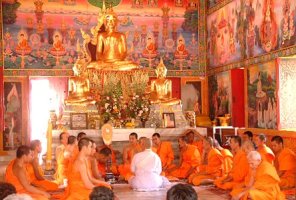ORDINATION

Ordination is a procedure marking a person's entry into the clergy. In Buddhism ordination has two steps. The first is called pabbajjà, `going forth', i.e. going forth from the household life into that of a homeless wanderer. The second is called upasampadà, `undertaking', i.e. undertaking all the duties and responsibilities of a fully ordained monk or nun. Buddhist clergy have no sacerdotal role or power and thus their ordination is just the conscious and publicly-announced decision to renounce the world, to live by the Vinaya and to strive with dedication to attain enlightenment.
To be ordained, a candidate must present himself before an assembly of ten senior monks of good standing, give his name, the name of the monk who has offered to train him and then satisfactorily answer 12 questions. (1) Do you have leprosy? (2) Do you have boils? (3) Do you have ringworm? (4) Do you have tuberculosis? (5) Do you have epilepsy? (6) Are you a human being? (7) Are you male? Ý or female in the case of one wishing to be a nun (8) Are you free from debt? (9) Are you free from obligations to the king? (10) Do you have your parent's (and husband's in the case of females) permission? (11) Are you 20 years old? (12) Do you have your robe and bowl? (Vin.I,93; II,271).
If the assembly is satisfied that the candidate is suitable, he will be accepted as a monk. Women wishing to be nuns must first undergo this procedure before an assembly of monks and again before an assembly of nuns. New monks or nuns will spend at least the next five years in `dependence' (nissaya) on their teacher who will train them and introduce them to the norms of the monastic life.
In Burma and Thailand there is a tradition of temporary ordination. Most males will spend a few weeks or months as a monk, usually in their teens. As this temporary ordination is done with the full intention of returning to the household life within a short time, and as no real renunciation of anything takes place, it is actually more a social ritual than a genuine ordination.
According to the Vinaya, if a monk wishes to become a lay man again he only has to inform his fellow monks of his decision, formally disrobe before them and leave the monastery. In practice, in all Buddhist countries, monks who disrobe (other than those temporarily ordained) are looked upon with considerable disapproval.